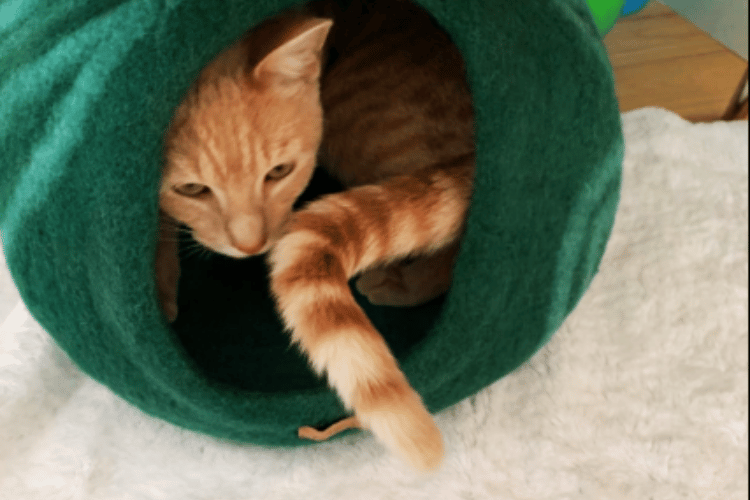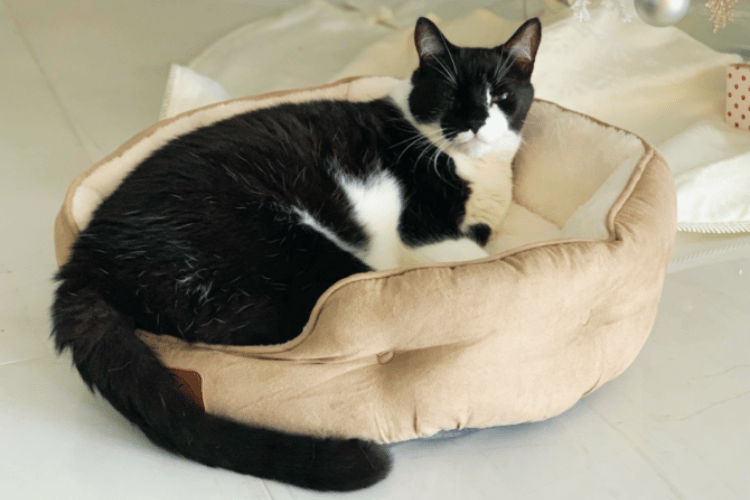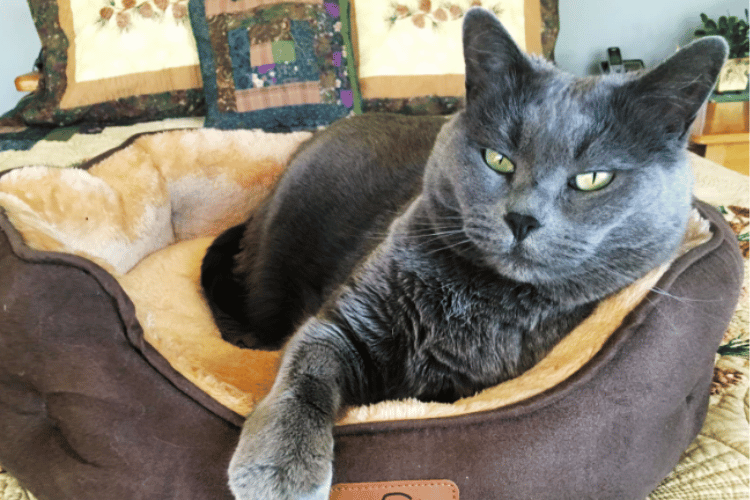Cats are enigmatic creatures, especially when it comes to their sleeping habits. If you've ever found your feline friend snoozing in a seemingly uncomfortable spot, you might have wondered, "What do cats like to sleep in?" This article will delve into the cozy corners and snug spaces that cats prefer for their restful retreats.
Key Takeaways:
- Cats seek out sleeping spots that provide warmth, safety, and comfort.
- Understanding a cat's sleeping preferences can help cat owners create ideal rest areas.
- A variety of options, from cat beds to cardboard boxes, can satisfy a cat's sleep needs.
The Quest for Warmth and Comfort
Cats love to sleep in places that offer warmth and comfort. Their ancestors were desert animals, which might explain their preference for basking in sunny spots around the house. A comfortable bed that retains body heat is often irresistible to a cat. Many cat beds are designed with this in mind, using materials that not only provide softness but also keep the kitty warm.

For older cats, a comfortable bed is even more crucial. As they age, they may develop arthritis or other joint issues, making a soft and supportive sleeping surface essential for their well-being. A bed with orthopedic foam can make all the difference for an older cat's comfort.
Safety is Paramount
Cats are both predators and prey in the wild, which is why safety is a significant factor in where they choose to sleep. A safe place is often one that is elevated, like a cat tree, which allows them to survey their surroundings and spot potential threats. It's not uncommon for cats to prefer sleeping in locations where they have easy access to escape routes, should they feel threatened.
In multi-pet households, cats may seek out spots where they can rest undisturbed by other pets. This could be a secluded room or a special cat tree where they can enjoy sleeping without interruption. Cats in a social group may also choose to sleep together for added warmth and security.
The Allure of Enclosed Spaces
Cats are notorious for their love of boxes. A simple cardboard box can be the perfect sleeping location for many cats. It provides a confined space where they can hide and feel safe from predators. The walls of the box also help to retain their body heat, making it a cozy spot for a nap.
Even in a home environment, the instinct to hide can be strong. Cats may choose enclosed spaces like cupboards or closets as their preferred sleeping locations. These areas provide the quiet and solitude that cats often crave when it's time to rest.

The Importance of REM Sleep
Just like humans, cats experience REM (rapid eye movement) sleep, which is essential for their health. During REM sleep, a cat's body can fully relax, and they often appear to be fast asleep. This is the stage of sleep where cats may dream, twitch their paws, or even move their ears.
Ensuring that a cat has a comfortable bed or sleeping area can promote better REM sleep. A bed that is too small or too hard might disturb their sleep cycle, preventing them from reaching this crucial stage of rest. Sure, let's expand the article with two new sections that will provide readers with additional insights into the sleeping habits of cats.
The Curiosity of Cats Sleeping with Other Cats
Cats are often perceived as solitary creatures, but when it comes to cat sleeping habits, they can surprise us. Domestic cats that grow up with other cats or are introduced properly may develop a bond that extends to their sleeping arrangements.
It's not uncommon to find cats curled up together, sharing warmth and companionship. This behavior is a throwback to their ancestors who huddled together for safety and warmth. For a cat owner, seeing their pets in a peaceful slumber side by side can be a heartwarming sight, indicating a harmonious household.

However, the dynamics of cats sleeping together can vary greatly. While some cats seek the comfort of their feline friends, others may prefer their own space. Factors such as personality, past experiences, and even the breed can influence whether a cat likes to share its sleeping quarters.
Observing how your cat sleeps with other cats can give you insights into their social preferences. It's important for cat owners to provide multiple cat beds or resting areas to accommodate the individual needs of each cat, ensuring that everyone has a comfortable spot to rest, whether alone or in company.
The Peculiar Sleeping Spots of Cats
Cats have a reputation for choosing the most unexpected places to catch their z's. From a seemingly uncomfortable perch atop a refrigerator to a cozy nook in a closet, cats sleep in a variety of peculiar spots.
A cat owner might be amused or perplexed to find their feline friend snoozing in the bathroom sink or curled up in a litter box (though this could indicate other issues if it becomes a habit). These choices are often driven by a cat's instinctual desire for a vantage point or a secure, enclosed space where they won't be easily disturbed.
Temperature plays a significant role in these quirky sleeping locations as well. Cats are drawn to warmth, so you might find them basking in a sunlit window or snuggled under a blanket on a cold night. They may even choose to sleep near electronic devices that emit heat.
While dogs might sprawl out on the cool floor, cats often seek out the coziest, warmest nooks they can find. Understanding these preferences can help a cat owner create an environment that caters to their pet's natural inclinations, ensuring their beloved feline gets the restful sleep they need.

The Role of Cat Trees
A cat tree is more than just a play area; it's also a popular sleeping spot for many felines. Cat trees often come with built-in beds or hammocks that provide both the elevation and comfort cats seek. For multiple cats, a cat tree with several levels can offer each cat their own space to sleep without feeling crowded.
Cat trees positioned near a window can also provide the added benefit of warmth from the sun, making them even more attractive as sleeping spots. Plus, the vantage point allows cats to watch the world go by, satisfying their curiosity and keeping them entertained before they drift off to sleep.
The Simplicity of a Cardboard Box
Never underestimate the appeal of a cardboard box to a cat. Cats sleeping in boxes is a common sight in many homes. The box's enclosed nature makes cats feel safe, and the cardboard provides insulation, keeping them warm. It's a simple and cost-effective solution for cat owners looking to provide additional sleeping locations for their pets.
Boxes can also be placed in various locations around the house, giving cats options for where they want to sleep. Some cats may even prefer a box over their own cat bed, much to the amusement (or bemusement) of their owners.
The Comfort of Your Lap
Many cats enjoy sleeping on their owner's lap. This location provides warmth, the comforting scent of their human, and a sense of security. For cats, their owner's lap is often the ultimate safe place, where they can relax completely and feel loved.
However, not all cats are lap cats. Some prefer to sleep nearby, perhaps on the same piece of furniture, but not directly on their owner. This still allows them to be close to their human while having their own space.

The Influence of Routine and Habit
Cats are creatures of habit, and this extends to their sleeping patterns. Once a cat chooses a preferred spot, they may return to it regularly for their naps. Cat owners can observe their cat's habits and place beds or blankets in those areas to enhance their comfort.
Cats may also change their preferred sleeping locations with the seasons. A spot that offers coolness during the summer may be swapped for a warmer one in the winter. Being attentive to these changes can help cat owners ensure their cats are comfortable year-round.
Summary
Cats have specific preferences when it comes to their sleeping arrangements. They seek out spots that provide warmth, comfort, and safety. From the luxurious cat bed to the humble cardboard box, there are many options that can satisfy a cat's sleep needs. By understanding these preferences, cat owners can create ideal sleeping environments that cater to their feline friend's natural instincts and habits.
FAQ Section
How much sleep do cats typically need?
Most cats require about 12-16 hours of sleep per day, though kittens and older cats may need more sleep.
Why does my cat like to sleep in high places?
Cats often prefer high places like cat trees because it gives them a sense of security and allows them to survey their surroundings, a behavior rooted in their natural instincts.
Should I let my cat sleep in my bed?
It's a personal choice. If you don't mind sharing your bed and it doesn't disrupt your sleep, it can be a way to bond with your cat. However, if you have allergies or prefer not to share your bed, providing your cat with its own comfortable bed is a good alternative.
Thank you for visiting LegitLists we hope this helps you make a legitimate choice!






